
ASUS Zenbook 14X OLED Space Edition vs Zenbook 14 OLED (UX3402) — which one is the laptop for you?
ASUS has just recently announced four new ASUS Zenbooks, and we will be looking at two of the more “mainstream” offerings. The ASUS Zenbook 14X OLED Space Edition and Zenbook 14 OLED (UX3402) are excellent options for anyone looking for an ultraportable, high-performance laptop. With that said, which one is the right one for you? Well, you came to the right place. We break it down into design, display, portability, connectivity, performance and value.
Design
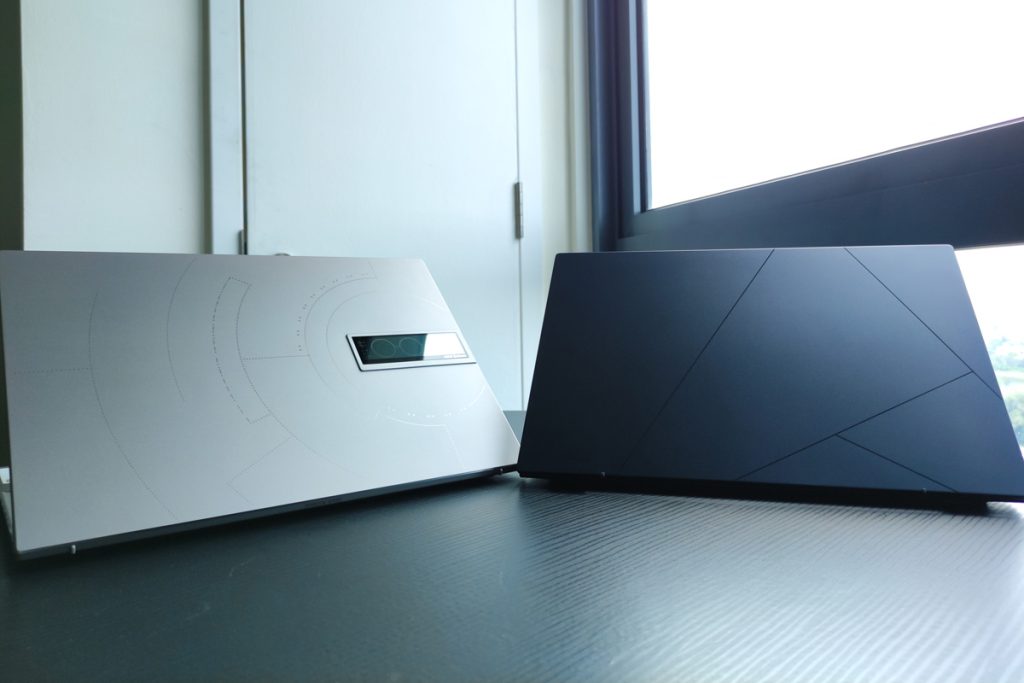
Both the ASUS Zenbook 14X OLED Space Edition and Zenbook 14 OLED are absolute lookers, but I would say that they each appeal to different crowds. The Zenbook 14X OLED Space Edition, as the name would probably have clued you in, is jampacked with space-inspired design elements. The lid, palm rest area and even the bottom cover tout various space-related trivia, and even Morse code. There’s also the ZenVision display, which definitely sets it apart from any other laptop out there.

It’s a real pity that ASUS decided to slap so many stickers on the palm rest of the Zenbook 14X OLED Space Edition, hiding some of the Morse code and emblems that the designers at ASUS worked so hard to integrate into the design.
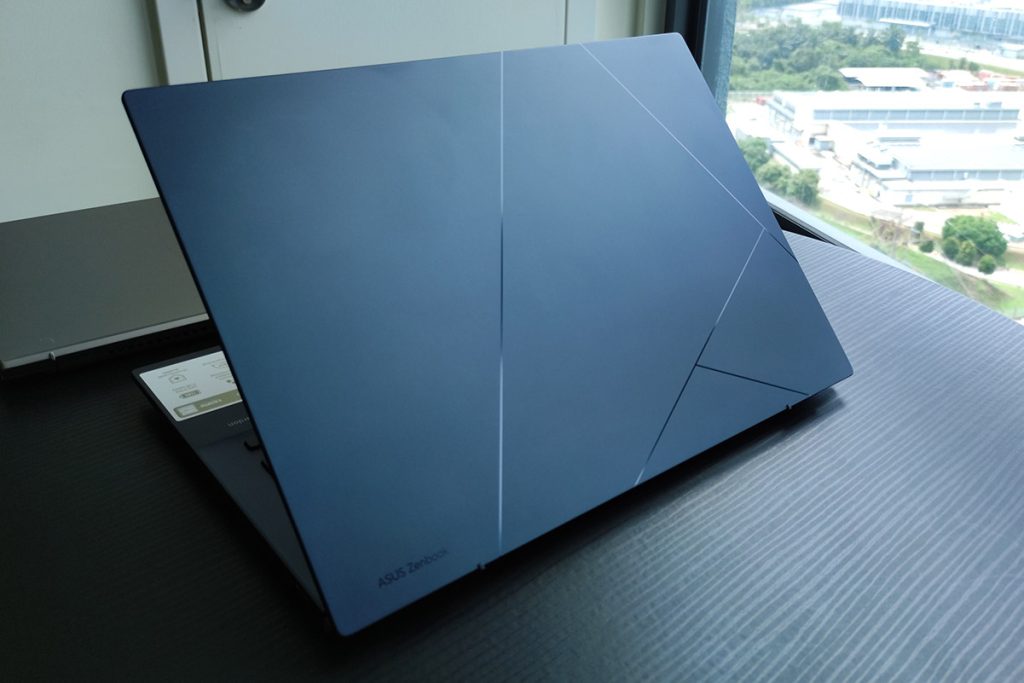
Meanwhile, we have the Zenbook 14 OLED adopting a more subtle approach to things, with the new ASUS monogram logo featured in a Kintsugi-inspired design on the lid. The deep Ponder Blue color option is also quite nice, although I can’t say I don’t miss the precision craftsmanship of the Zen concentric circles found on previous Zenbooks. For that, you will have to look at the recently announced Zenbook Pros.
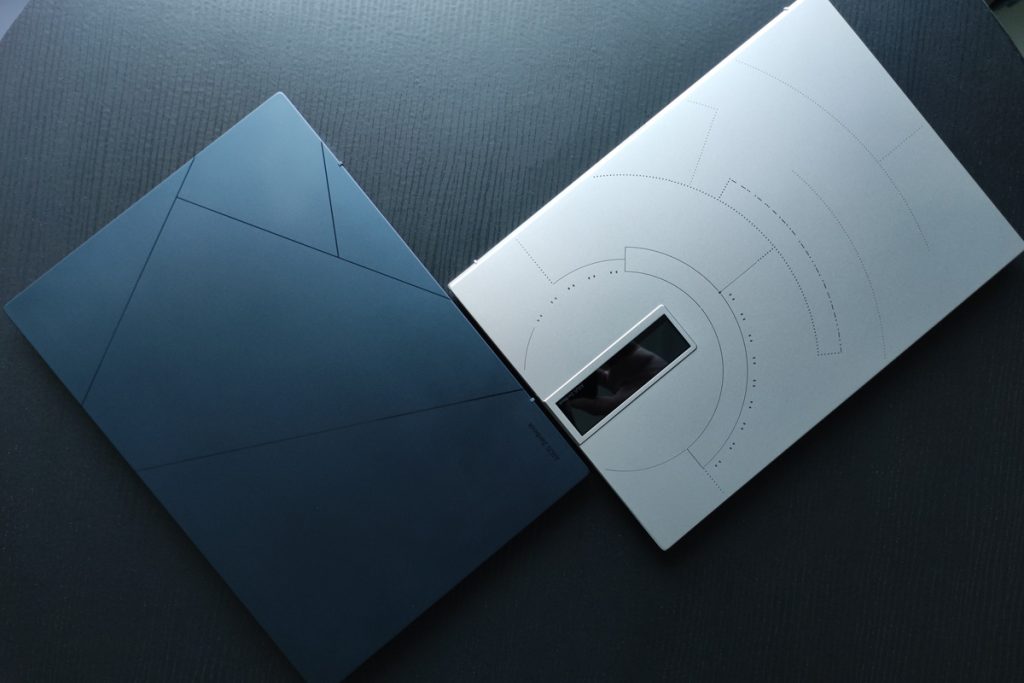
It’s hard to pick a winner when it comes to design, especially due to the different demographics that these two laptops are targeted towards. For the space enthusiasts or those who appreciate the novelty of the commemorative space-inspired design infused all over its chassis, the Zenbook 14X OLED Space Edition will surely come out on top. Heck, ASUS even went to the lengths of customizing the boot animation to one that suits the theme. For the sheer attention to detail, the Zenbook 14X OLED Space Edition comes out on top here.
Display

Both displays are technically the same, with both laptops offering the same 14″ 2.8K 90Hz OLED display panel. It seems that our local variants have some slight differences though — the Zenbook 14 OLED is capable of going slightly brighter, and also maintaining DC dimming down to its minimum brightness, instead of the Zenbook 14X OLED Space Edition’s limit of 60%, after which it falls back on PWM dimming. During my use of both laptops, I didn’t encounter any issues with this, although I do know that some people might be sensitive to the rapid switching of PWM.
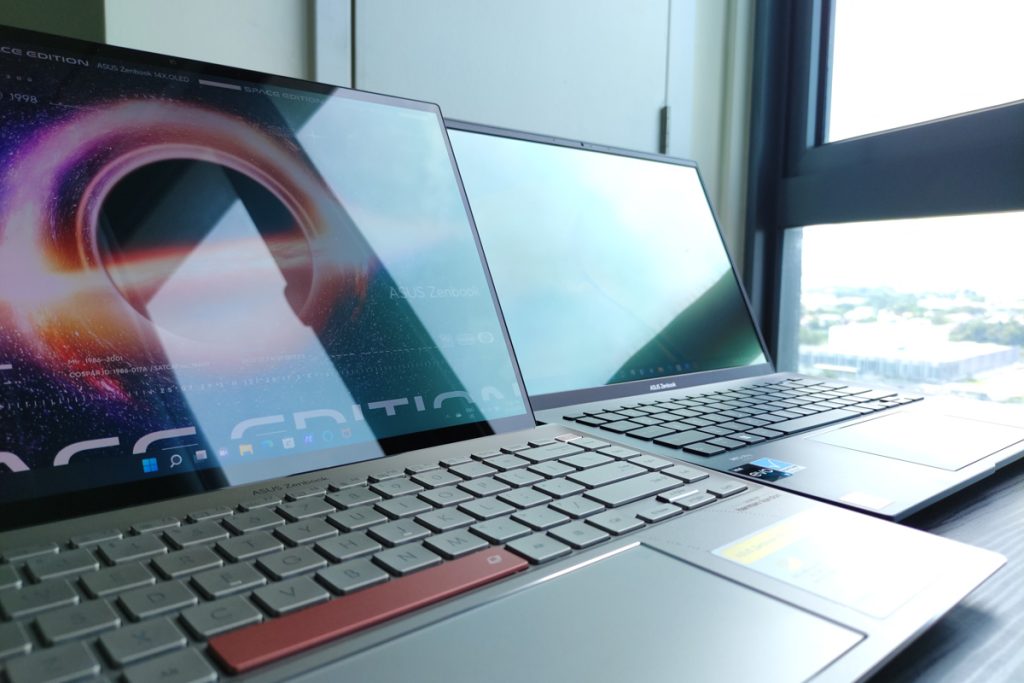
Another difference is the fact that the Zenbook 14X OLED Space Edition touts a touch-sensitive display. The Zenbook 14 OLED doesn’t, and if you asked me a few months earlier, I would say that I honestly don’t mind not having a touchscreen. However, after using more than my fair share of touch displays, I have actually gotten quite used to them, and the fact that the Zenbook 14 OLED doesn’t have one did irk me more than I would like to admit.
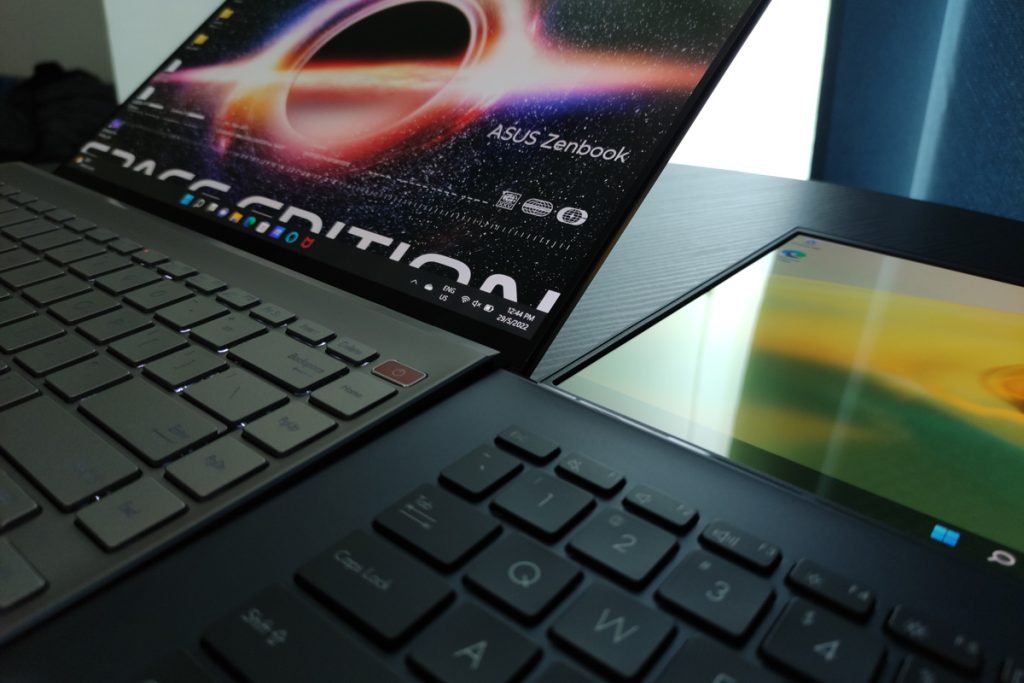
Last but not least, the hinge. Yes, this is probably a very minor consideration for most users, but the hinge of the Zenbook 14 OLED allows the screen to lay flat, or what some will call a 180-degree hinge, while the Zenbook 14X OLED Space Edition tops out at about 120-degrees. Unless you often present stuff to the person seated opposite you, I wouldn’t really consider this to affect my purchase decision.
Due to the fact that each laptop here touts an advantage over the other in small areas, I would consider this to be a tie between the two laptops.
Portability
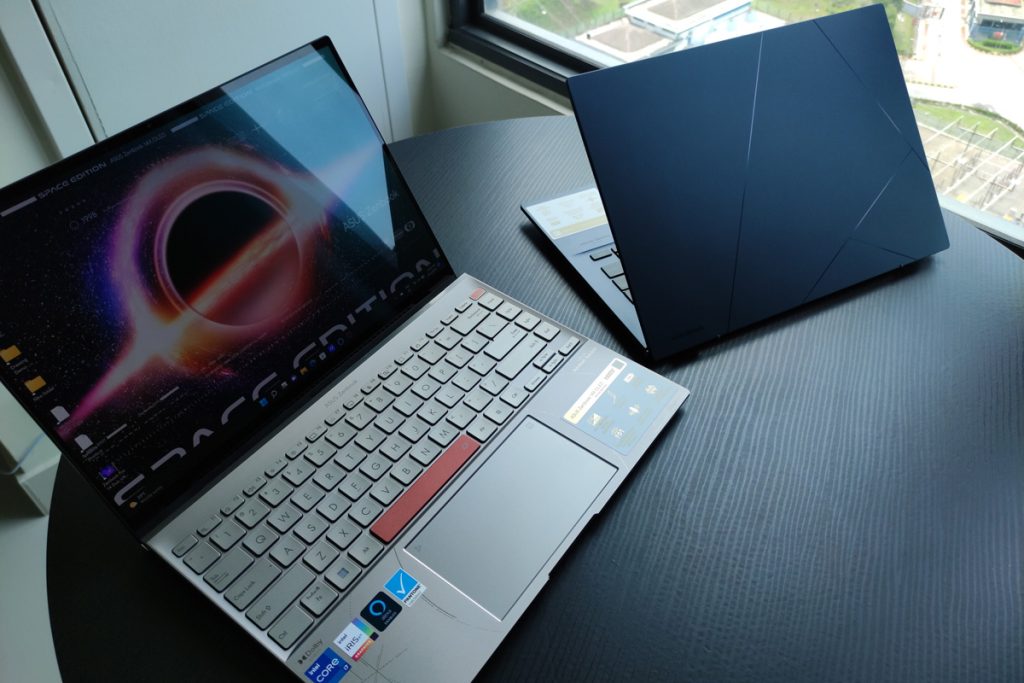
On paper, the Zenbook 14 OLED and Zenbook 14X Space Edition are pretty similar in terms of portability. In fact, the Zenbook 14X Space Edition is marginally thinner and narrower, while weighing just 0.1kg more. In practice, the Zenbook 14 OLED I have here is noticeably lighter, presumably due to the fact that we do not have a glass cover over the display to facilitate the touch capabilities featured on the Zenbook 14X OLED Space Edition.

As expected, the Zenbook 14 OLED delivers significantly better battery life than the Zenbook 14X OLED Space Edition. We are looking at nearly three hours better endurance, or 43% longer battery life. This can easily be attributed to its lower power consumption and larger battery. Portability is therefore an easy win for the Zenbook 14 OLED UX3402. However last year’s Zenbook 14 UX425E still trumps it, with close to four hours of extra juice…
Back to the comparison between the two 2022 Zenbooks, the Zenbook 14 OLED UX3402 easily takes the cake here, with its lighter weight and significantly longer endurance.
Connectivity

The connectivity options of both laptops we have here today are identical — two Thunderbolt 4 USB-C connectors, one USB 3.2 Gen 2 Type-A port, one full-sized HDMI 2.0 port, a microSD card slot and a 3.5mm combo audio jack. However the orientation of the ports are virtually mirrored, due to the difference in the way that ASUS designed the cooling systems in them. For wireless connectivity, both tout Intel WiFi 6E and Bluetooth 5.2, so no differences here.

As both laptops feature the same connectivity, there will be no winners here. It’s a tie! If you want to force a winner, I would give it to the Zenbook 14X OLED Space Edition, as the USB-C ports for charging are on the left, keeping them out of my mouse’s way. Of course, that’s only a thing if you are right handed. If you are left handed, the balance swings towards the Zenbook 14 OLED’s right-sided ports.
Performance
Comparing a laptop with a 12th Gen Intel Core H-series processor versus one with a 12th Gen Intel Core P-series processor is going to give you results that you can probably already expect.
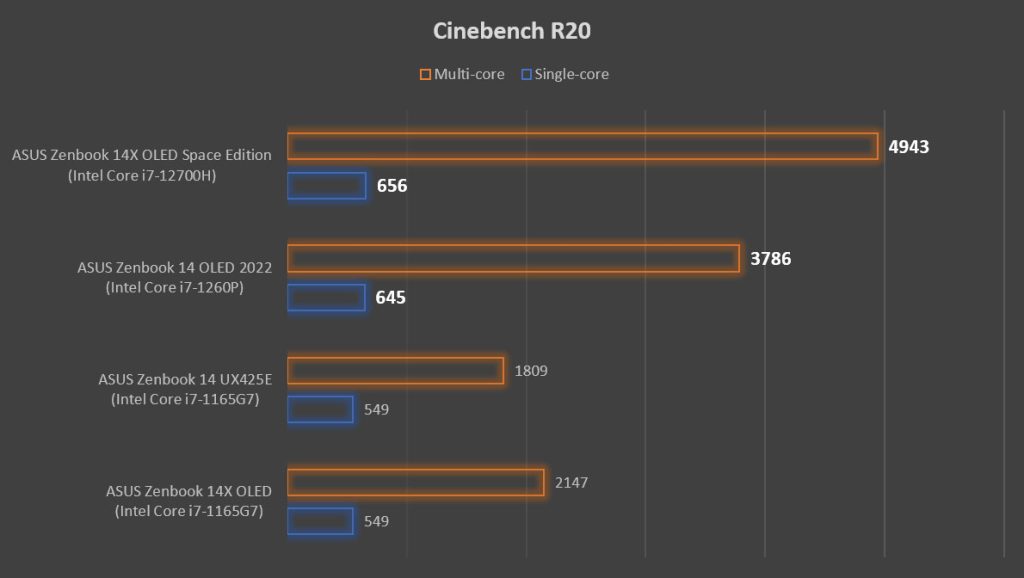
Cinebench R20 puts the Zenbook 14X OLED Space Edition and its Core i7-12700H at more than 30% faster in multi-core than the Zenbook 14 OLED with its Core i7-1260P, owing to a rather large difference in TDP (45W vs 28W) and a smaller difference in core count (14-core vs 12-core). Single core performance is markedly similar, with a mere 1.7% difference between the two.
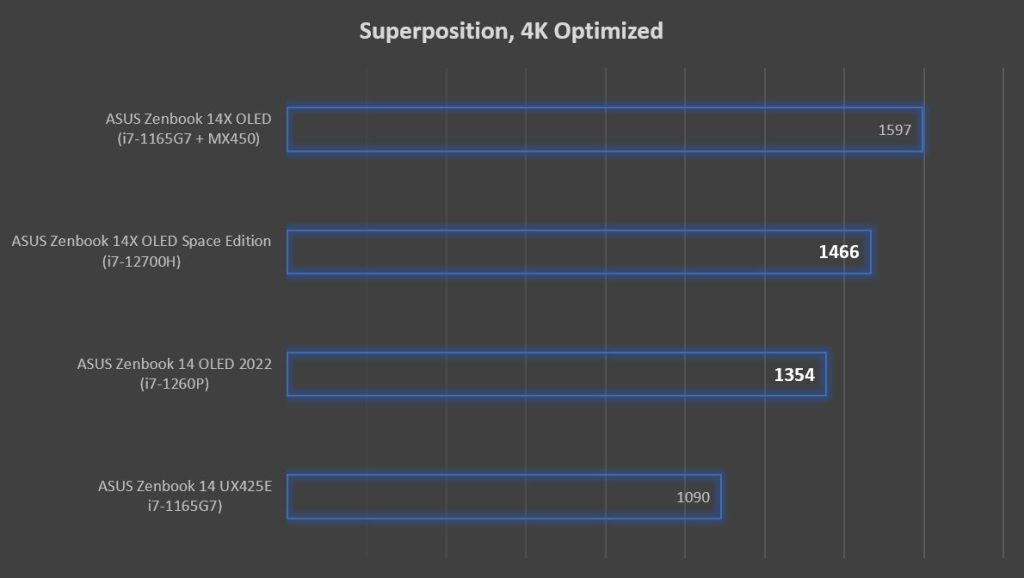
There’s little difference between the Zenbook 14X OLED Space Edition and Zenbook 14 OLED UX3402 when it comes to graphics performance, probably due to the fact that they both have the same 96 execution units clocked at up to 1.4GHz. Any difference can probably be attributed to the difference in power budgets, with the Space Edition going all the way up to 45W.
However we do see in excess of 24% improvement over a similar iGPU-based configuration from last year, which I believe can be attributed to the increased clock speeds, power limits and the use of LPDDR5, the latter which enhances memory bandwidth significantly. However it’s still no match for the dedicated MX450 graphics in the Zenbook 14X OLED , which is perched at the top of the charts.
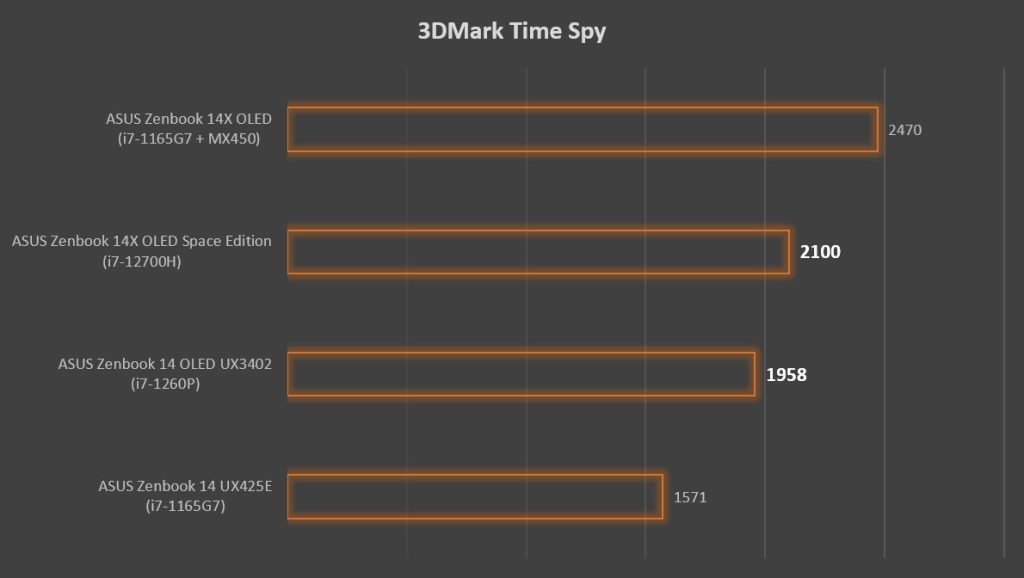
3DMark sees a similar scenario, with the Zenbook 14X OLED Space Edition barely outpacing the Zenbook 14 OLED UX3402. Last year’s Zenbook 14X OLED with its MX450 is still at the top of this chart, while the Zenbook 14 UX425E rests comfortably at the bottom.
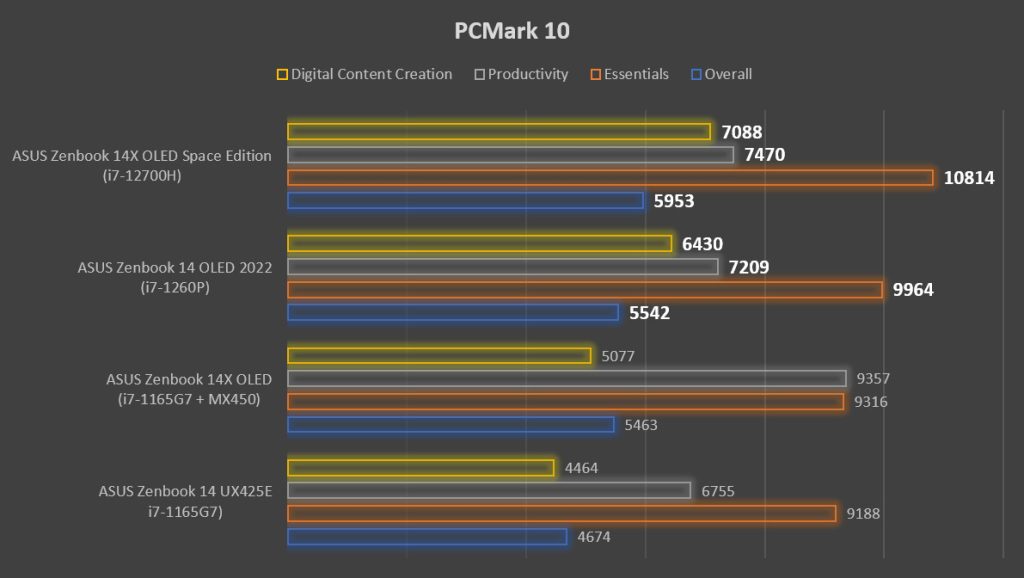
For more demanding users, the Zenbook 14X OLED Space Edition does come up to be 10% faster in PCMark 10’s suite versus the Zenbook 14 OLED, but more on that later. The overall performance of the 2022 Zenbooks leave last year’s models in the dust, but the Zenbook 14X OLED with its MX450 does come out as the fastest laptop in this stack in the Productivity section. Never knew graphics contributed to performance in office applications… In any case, we can see that the Digital Content Creation performance of the 2022 Zenbooks is slightly faster than the 2021 offerings, so we probably should see light content creators much happier with this year’s models.
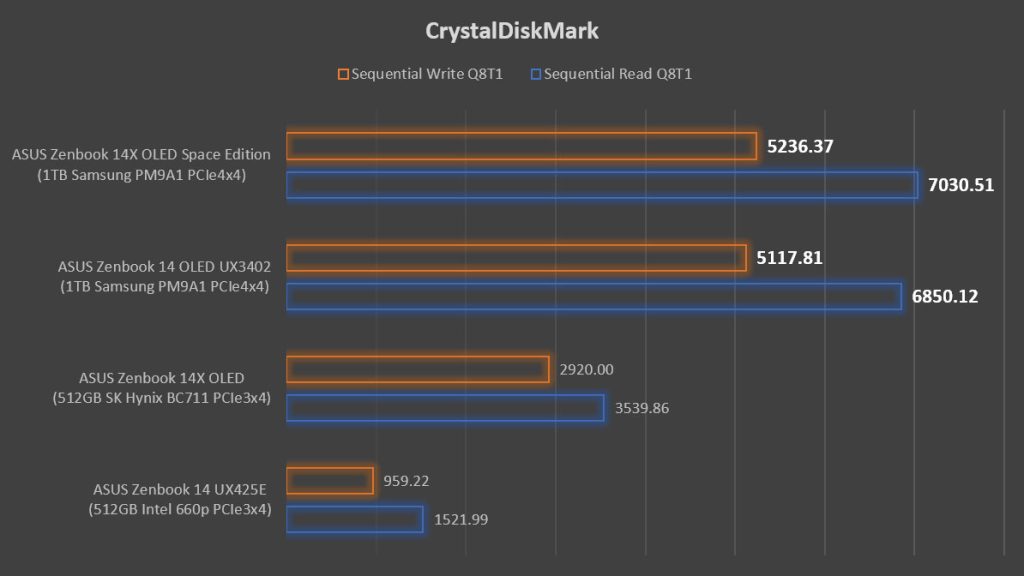
Storage performance of the latest Zenbooks are superb, thanks to the use of PCIe 4.0 SSDs. Somehow despite both the Zenbook 14X OLED Space Edition and Zenbook 14 OLED UX3402 featuring the same Samsung PM9A1 SSD, the Space Edition manages slightly faster speeds. A somewhat notable improvement is also that we are seeing double the storage this year, which is always welcome. And of course, I am happiest to note that the Intel 660p is left in the dust, as it should be.
When it comes to power consumption and cooling, things do get more interesting. In Realbench’s stress test, the Core i7-12700H draws 35.9W, while the Zenbook 14 OLED draws 31.5W, on average. That’s 14% extra power consumption. Interestingly enough, the PL1 limit of the Zenbook 14 OLED only drops from 35W to 30W over the 15-minute Realbench stress test, while the Zenbook 14X OLED Space Edition has a more significant drop, from 64W to 35W. The higher initial power limit should allow the Zenbook 14X OLED Space Edition to shine in short bursts of activity, while the more conservative long-term limit allows for lower temperatures.
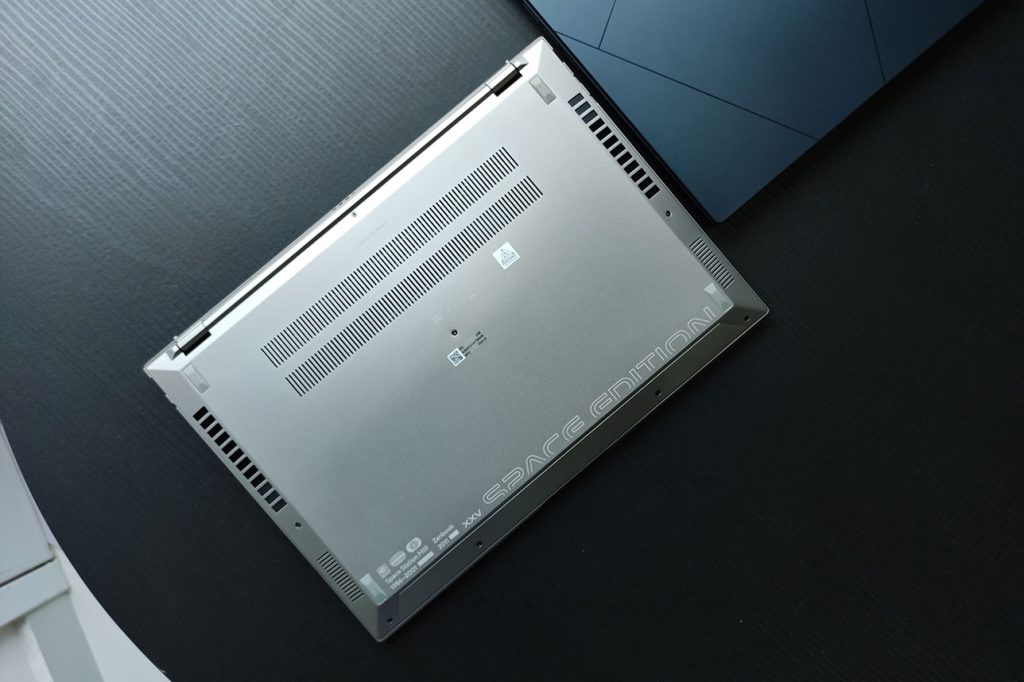
Surprisingly enough, thermals on the Zenbook 14 OLED are also significantly higher despite the lower power draw, due to a simpler cooler design which involves only a single fan and heatpipe combo. Peak temperatures of up to 98°C were observed, while the Zenbook 14X OLED Space Edition’s dual-fan, dual-heatpipe system manages to keep thing below 90°C. The difference in average temperatures is more significant — the Zenbook 14 OLED averages 86.4°C, while the Zenbook 14X OLED Space Edition averages 75.3°C, an 11.1°C difference.
In normal use, the Zenbook 14 OLED has its fans spool up quite quickly, although I wouldn’t say that the fan noise is irritating. It’s just… audible. The palm rest and keyboard areas also warm up quickly with any sort of workload aside from the most basic ones which is indicative of a cooling system that isn’t quite cut out for the task at hand.
For raw performance, the Zenbook 14X OLED Space Edition easily wins here. Cooling performance is also in its favor, as I can’t say that I am comfortable with the toasty temperatures I am experiencing on the Zenbook 14 OLED. The Zenbook 14X OLED Space Edition wins here.
Specifications
| ASUS Zenbook 14X OLED Space Edition (UX5401Z) | ASUS Zenbook 14 OLED (UX3402) | |
| Processor | Intel Core i7-12700H, 14C/20T (6P + 8E) @ up to 4.7GHz 24MB L3 cache 45W TDP Intel 7 | Intel Core i7-1260P, 12C/16T (4P+8E) @ up to 4.7GHz 18MB L3 cache 28W TDP Intel 7 |
| RAM | 16GB LPDDR5-4800, on-board, quad-channel | 16GB LPDDR5-4800, on-board, quad-channel |
| Graphics | Intel Iris Xe Graphics, 96EU @ up to 1.4GHz | Intel Iris Xe Graphics, 96EU @ up to 1.4GHz |
| Storage | 1TB Samsung PM9A1 SSD (M.2 PCIe 4.0×4 NVMe SSD) | 1TB Samsung PM9A1 SSD (M.2 PCIe 4.0×4 NVMe SSD) |
| Display | 14″ 2.8K 16:10 (2880 x 1800) 90Hz OLED Samsung SD4154 display 550 nits peak brightness, 100% DCI-P3 gamut, PANTONE Validated Touch sensitive 92% screen-to-body ratio | 14″ 2.8K 16:10 (2880 x 1800) 90Hz OLED Samsung SDC4171 display 600 nits peak brightness, 100% DCI-P3 gamut, PANTONE Validated 90% screen-to-body ratio |
| Audio | Stereo speakers (with Smart Amp Technology) harman/kardon (Premium) Array microphone | Stereo speakers (with Smart Amp Technology) harman/kardon (Premium) Array microphone |
| Connectivity | 2 x Thunderbolt 4 with display-out, USB-PD support 1 x USB-A (USB 3.2 Gen 2, 10Gbps) 1 x HDMI 2.0b 1 x 3.5mm audio jack MicroSD card reader | 2 x Thunderbolt 4 with display-out, USB-PD support 1 x USB-A (USB 3.2 Gen 2, 10Gbps) 1 x HDMI 2.0b 1 x 3.5mm audio jack MicroSD card reader |
| Battery | 63WHr 3-cell Li-ion battery 100W USB-PD power adapter | 75WHr 4-cell Li-ion battery 65W USB-PD power adapter |
| Dimensions | 311.2 x 221.1 x 15.9 mm | 313.6 x 220.6 x 16.9 mm |
| Weight | 1.4kg | 1.39kg |
Verdict
The two laptops are quite clearly designed for two separate demographics, even though they are practically in the same price bracket. The Zenbook 14 OLED starts from RM4399, although the variant we reviewed is priced at RM5599. That’s the starting price of the Zenbook 14X OLED Space Edition, but once again, we reviewed the higher end model, which is at RM6499. So, with the prices out of the way, which one should you get?
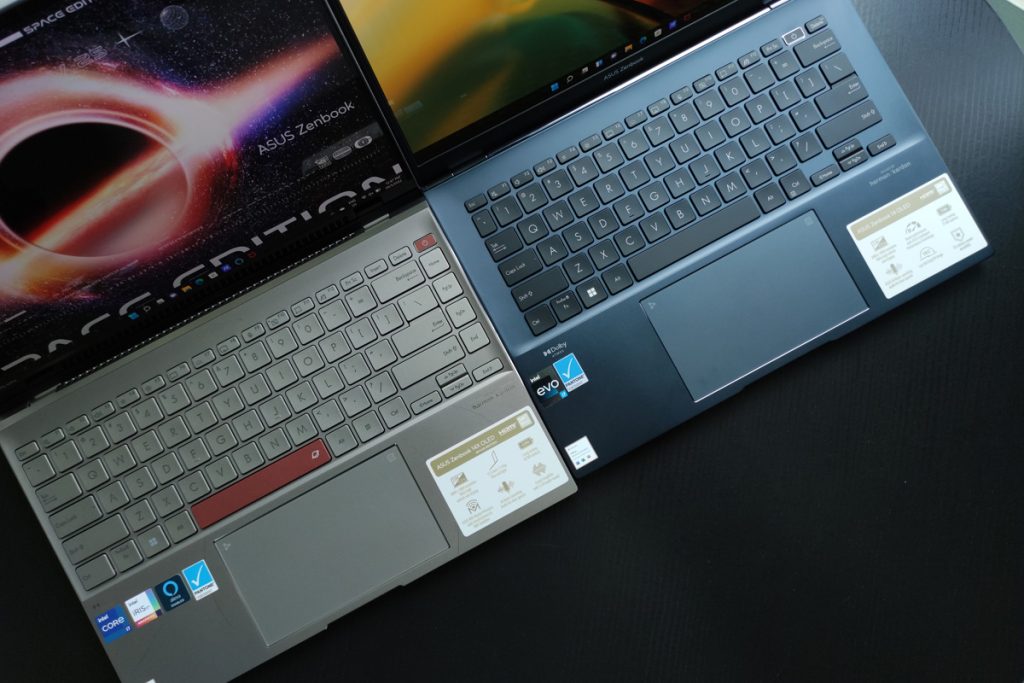
If what you are looking for is an ultraportable that gets the job done, the Zenbook 14 OLED, even the more affordable Core i5 variant, should be more than sufficient for your needs. If you need more raw performance, the Zenbook 14X OLED Space Edition is probably going to be more suitable for you. And of course, if you are a big fan of all things space, there is no other option other than the Zenbook 14X OLED Space Edition.
Personally, I will opt for the Zenbook 14 OLED, as it fits my needs for a portable workhorse that I can rely on without having to worry about battery life. Hopefully the Core i5 variant is less affected by the less-than-stellar cooling here. It’s also more affordable, so as a cheapskate, my decision is even further skewed towards it.





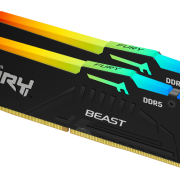
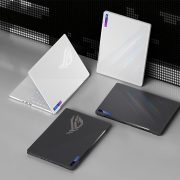
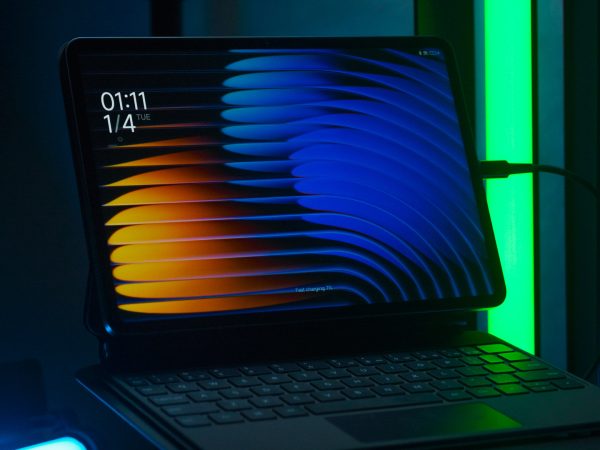


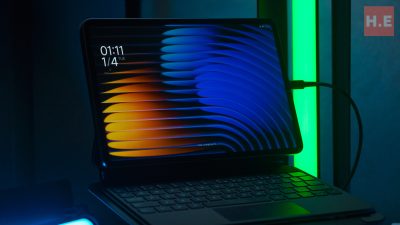
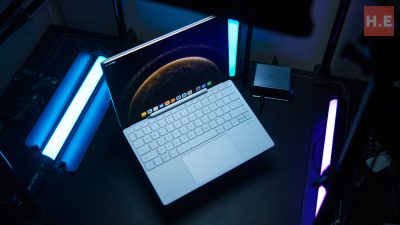
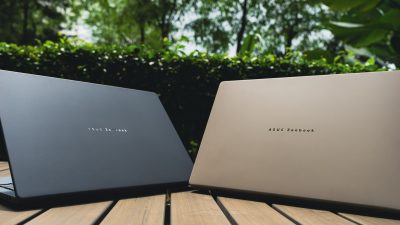

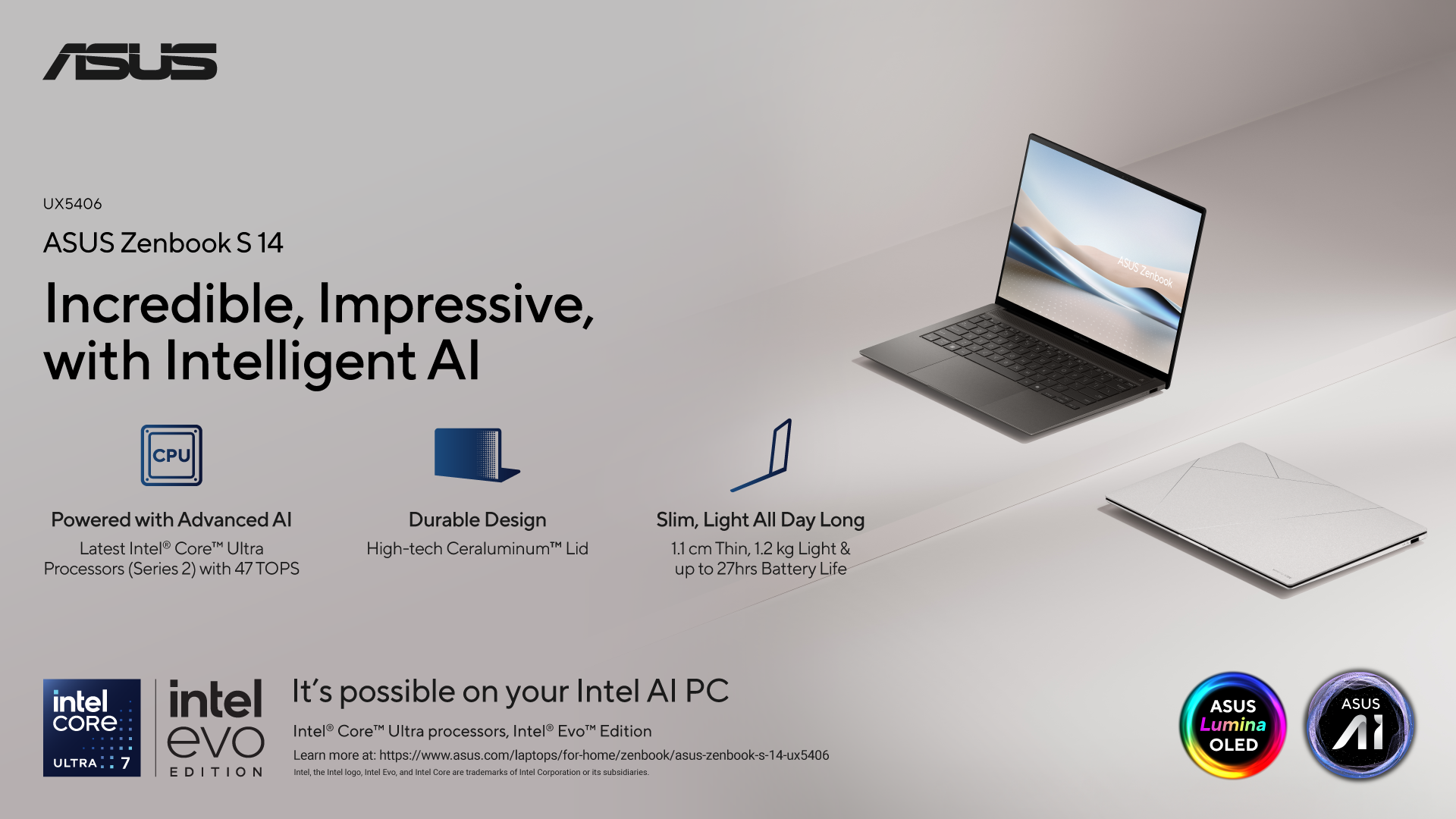
[…] more ports. However, all we get is what seems like the standard set of ports that we find across virtually every recent Zenbook — two Thunderbolt 4, one USB 3.2 Gen 2 Type-A and a full-sized HDMI 2.1 port. Slightly different […]
[…] you thought the ASUS Zenbook 14 OLED looked premium, well you haven’t seen nothing yet. Instead of the Kintsugi-inspired design, […]
[…] build, with a space-inspired design that I do think goes quite well, especially if you carry a Zenbook 14X OLED Space Edition, like […]
[…] highlight of this laptop is its display. Remember the Zenbook 14X OLED Space Edition and Zenbook 14 OLED we reviewed previously? This laptop has the same display panel as the Zenbook 14 OLED: a 14″ […]